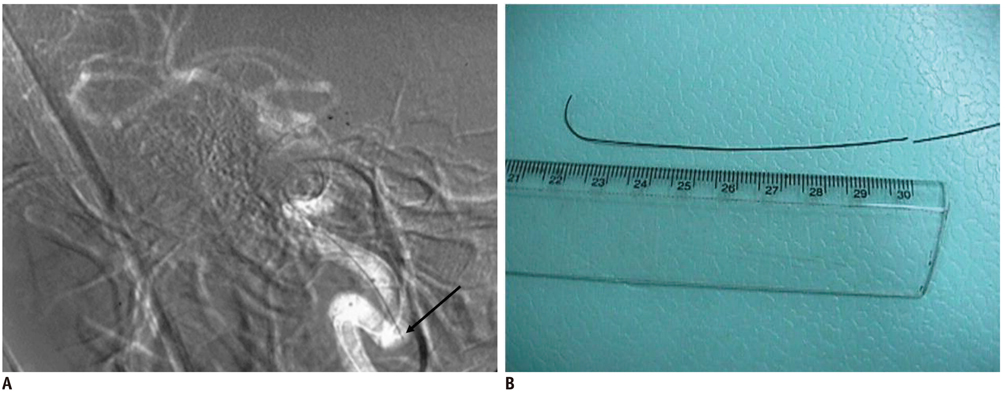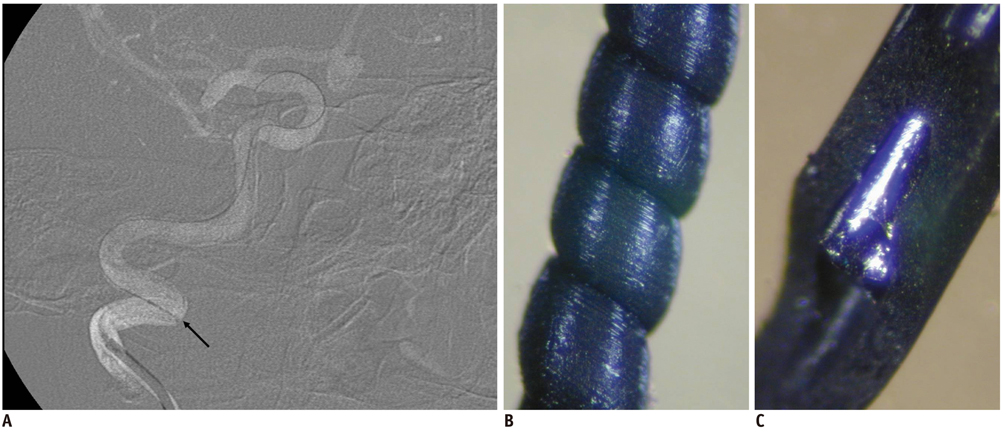Korean J Radiol.
2011 Oct;12(5):638-640. 10.3348/kjr.2011.12.5.638.
Guidewire Breakage during Neurointerventional Procedures: a Report of Two Cases
- Affiliations
-
- 1Department of Radiology, Wonju College of Medicine, Yonsei University, Gangwon-do 220-701, Korea.
- 2Department of Neurosurgery, Wonju College of Medicine, Yonsei University, Gangwon-do 220-701, Korea.
- 3Department of Neurosurgery, Seoul National University Bundang Hospital, Gyeonggi-do 463-707, Korea. kwonoki@snu.ac.kr
- KMID: 1116452
- DOI: http://doi.org/10.3348/kjr.2011.12.5.638
Abstract
- We report on two cases of microguidewire breakage that occurred during endovascular treatment of intracranial aneurysms. The microguidewire can be broken when a part of the wire is stuck due to vascular tortuosity, and, subsequently, application of excessive rotational movement. The mechanical and physical properties of a microguidewire are also important factors in microguidewire breakage. We also suggest technical tips for avoidance of this problem.
Keyword
MeSH Terms
Figure
Reference
-
1. Stellin G, Ramondo A, Bortolotti U. Guidewire fracture: an unusual complication of percutaneous transluminal coronary angioplasty. Int J Cardiol. 1987. 17:339–342.2. Sethi GK, Ferguson TB Jr, Miller G, Scott SM. Entrapment of broken guidewire in the left main coronary artery during percutaneous transluminal coronary angioplasty. Ann Thorac Surg. 1989. 47:455–457.3. Kilic H, Akdemir R, Bicer A. Rupture of guide wire during percutaneous transluminal coronary angioplasty, a case report. Int J Cardiol. 2008. 128:e113–e114.4. Ceschinski H, Henkes H, Weinert HC, Weber W, Kuhne D, Monstadt H. Torquability of microcatheter guidewires: the resulting torsional moment. Biomed Mater Eng. 2000. 10:31–42.
- Full Text Links
- Actions
-
Cited
- CITED
-
- Close
- Share
- Similar articles
-
- Guidewire Breakage: An Unusual Complication of Anterior Odontoid Cannulated Screw Fixation
- Neuroform-EZ Stent Modification for Facilitated Delivery during Intracranial Aneurysm Embosurgery
- Usefulness of the double-guidewire technique for endoscopic procedures in the field of biliary and pancreatic diseases
- Guidewire Impaction in the Main Pancreatic Duct in a Patient with Chronic Pancreatitis: A Case Report
- Use of a Balloon Catheter for Occlusion of Iatrogenic Direct Carotid-Cavernous Fistula Occurring during a Neurointerventional Procedure



